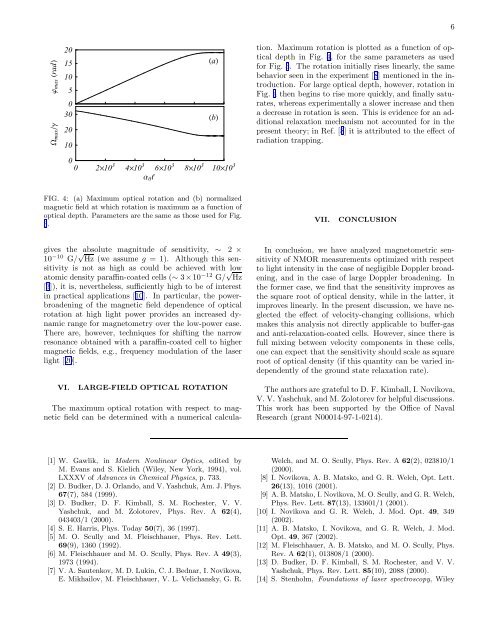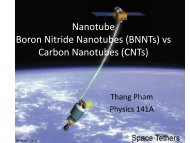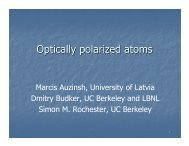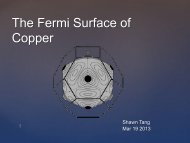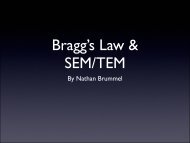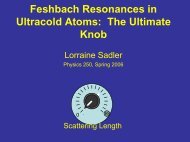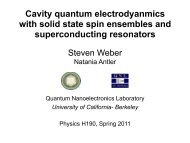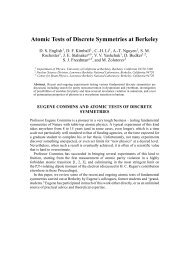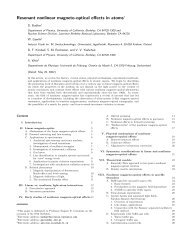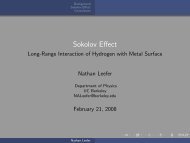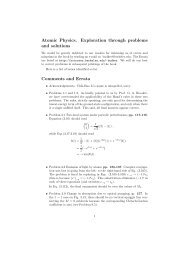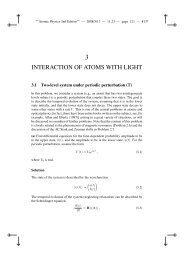Nonlinear magneto-optical rotation in optically thick media
Nonlinear magneto-optical rotation in optically thick media
Nonlinear magneto-optical rotation in optically thick media
Create successful ePaper yourself
Turn your PDF publications into a flip-book with our unique Google optimized e-Paper software.
maxΓ φmax rad20151050302010ab00 210 3 410 3 610 3 810 3 1010 3Α 0 {The maximum <strong>optical</strong> <strong>rotation</strong> with respect to magneticfield can be determ<strong>in</strong>ed with a numerical calculation.Maximum <strong>rotation</strong> is plotted as a function of <strong>optical</strong>depth <strong>in</strong> Fig. 4, for the same parameters as usedfor Fig. 3. The <strong>rotation</strong> <strong>in</strong>itially rises l<strong>in</strong>early, the samebehavior seen <strong>in</strong> the experiment [8] mentioned <strong>in</strong> the <strong>in</strong>troduction.For large <strong>optical</strong> depth, however, <strong>rotation</strong> <strong>in</strong>Fig. 4 then beg<strong>in</strong>s to rise more quickly, and f<strong>in</strong>ally saturates,whereas experimentally a slower <strong>in</strong>crease and thena decrease <strong>in</strong> <strong>rotation</strong> is seen. This is evidence for an additionalrelaxation mechanism not accounted for <strong>in</strong> thepresent theory; <strong>in</strong> Ref. [8] it is attributed to the effect ofradiation trapp<strong>in</strong>g.6FIG. 4: (a) Maximum <strong>optical</strong> <strong>rotation</strong> and (b) normalizedmagnetic field at which <strong>rotation</strong> is maximum as a function of<strong>optical</strong> depth. Parameters are the same as those used for Fig.3.VII.CONCLUSIONgives the absolute magnitude of sensitivity, ∼ 2 ×10 −10 G/ √ Hz (we assume g = 1). Although this sensitivityis not as high as could be achieved with lowatomic density paraff<strong>in</strong>-coated cells (∼ 3×10 −12 G/ √ Hz[3]), it is, nevertheless, sufficiently high to be of <strong>in</strong>terest<strong>in</strong> practical applications [10]. In particular, the powerbroaden<strong>in</strong>gof the magnetic field dependence of <strong>optical</strong><strong>rotation</strong> at high light power provides an <strong>in</strong>creased dynamicrange for <strong>magneto</strong>metry over the low-power case.There are, however, techniques for shift<strong>in</strong>g the narrowresonance obta<strong>in</strong>ed with a paraff<strong>in</strong>-coated cell to highermagnetic fields, e.g., frequency modulation of the laserlight [20].VI.LARGE-FIELD OPTICAL ROTATIONIn conclusion, we have analyzed <strong>magneto</strong>metric sensitivityof NMOR measurements optimized with respectto light <strong>in</strong>tensity <strong>in</strong> the case of negligible Doppler broaden<strong>in</strong>g,and <strong>in</strong> the case of large Doppler broaden<strong>in</strong>g. Inthe former case, we f<strong>in</strong>d that the sensitivity improves asthe square root of <strong>optical</strong> density, while <strong>in</strong> the latter, itimproves l<strong>in</strong>early. In the present discussion, we have neglectedthe effect of velocity-chang<strong>in</strong>g collisions, whichmakes this analysis not directly applicable to buffer-gasand anti-relaxation-coated cells. However, s<strong>in</strong>ce there isfull mix<strong>in</strong>g between velocity components <strong>in</strong> these cells,one can expect that the sensitivity should scale as squareroot of <strong>optical</strong> density (if this quantity can be varied <strong>in</strong>dependentlyof the ground state relaxation rate).The authors are grateful to D. F. Kimball, I. Novikova,V. V. Yashchuk, and M. Zolotorev for helpful discussions.This work has been supported by the Office of NavalResearch (grant N00014-97-1-0214).[1] W. Gawlik, <strong>in</strong> Modern <strong>Nonl<strong>in</strong>ear</strong> Optics, edited byM. Evans and S. Kielich (Wiley, New York, 1994), vol.LXXXV of Advances <strong>in</strong> Chemical Physics, p. 733.[2] D. Budker, D. J. Orlando, and V. Yashchuk, Am. J. Phys.67(7), 584 (1999).[3] D. Budker, D. F. Kimball, S. M. Rochester, V. V.Yashchuk, and M. Zolotorev, Phys. Rev. A 62(4),043403/1 (2000).[4] S. E. Harris, Phys. Today 50(7), 36 (1997).[5] M. O. Scully and M. Fleischhauer, Phys. Rev. Lett.69(9), 1360 (1992).[6] M. Fleischhauer and M. O. Scully, Phys. Rev. A 49(3),1973 (1994).[7] V. A. Sautenkov, M. D. Luk<strong>in</strong>, C. J. Bednar, I. Novikova,E. Mikhailov, M. Fleischhauer, V. L. Velichansky, G. R.Welch, and M. O. Scully, Phys. Rev. A 62(2), 023810/1(2000).[8] I. Novikova, A. B. Matsko, and G. R. Welch, Opt. Lett.26(13), 1016 (2001).[9] A. B. Matsko, I. Novikova, M. O. Scully, and G. R. Welch,Phys. Rev. Lett. 87(13), 133601/1 (2001).[10] I. Novikova and G. R. Welch, J. Mod. Opt. 49, 349(2002).[11] A. B. Matsko, I. Novikova, and G. R. Welch, J. Mod.Opt. 49, 367 (2002).[12] M. Fleischhauer, A. B. Matsko, and M. O. Scully, Phys.Rev. A 62(1), 013808/1 (2000).[13] D. Budker, D. F. Kimball, S. M. Rochester, and V. V.Yashchuk, Phys. Rev. Lett. 85(10), 2088 (2000).[14] S. Stenholm, Foundations of laser spectroscopy, Wiley


